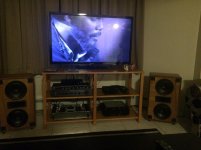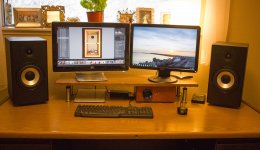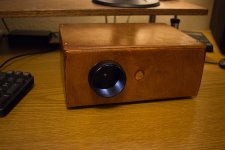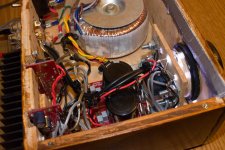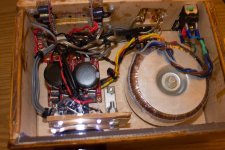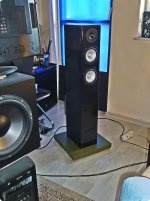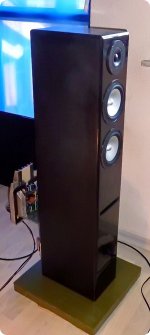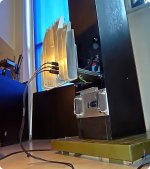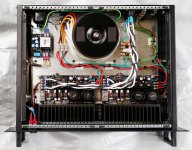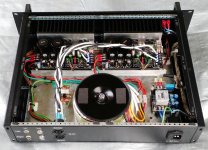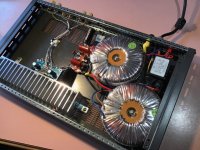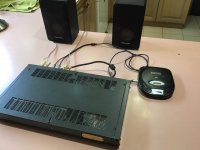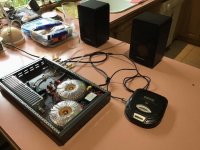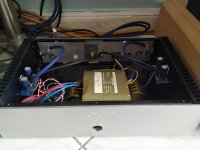Chris, thanks for your comments. The XO is an ART 310 with 4th order LR filters and an adjustable XO point from 80 Hz to 9 kHz in 2 ranges. Independent level adjustment on all outputs makes it easy to dial in. Speakers are home built cabinets circa 1990 which have housed several different drivers over the years. Currently dual 8" poly woofers, a horn tweeter and a 10" passive radiator on the rear. Of course with the new amp, plans for new speakers are in the works.
Attachments
Desktop LM3886
Built this a couple of years ago with some help from people around here, never got around to posting the final product.
Closely based on WWWJD's LM3886 Gainclone over at PE. He is a bit more of a craftsman than I am but I am still happy with my results. I did not, however, integrate the DAC like he did. I wanted to be able to change out at some point so it just has coax inputs for now and a litty HiFiMeDIY U2 DAC.
Has a very slight hum even with input disconnected. Probably because of everything's proximity to trafo but let me know if you see something obvious. It is not audible over the air handler so haven't had any reason to really go digging. Other than that the sound is incredible. Any decent source fine feels like they are in the room with you.
Still need to make a desk riser that is full width to get the Hitmaker's up to the right height, but pretty close to done with my desktop setup.
Built this a couple of years ago with some help from people around here, never got around to posting the final product.
Closely based on WWWJD's LM3886 Gainclone over at PE. He is a bit more of a craftsman than I am but I am still happy with my results. I did not, however, integrate the DAC like he did. I wanted to be able to change out at some point so it just has coax inputs for now and a litty HiFiMeDIY U2 DAC.
Has a very slight hum even with input disconnected. Probably because of everything's proximity to trafo but let me know if you see something obvious. It is not audible over the air handler so haven't had any reason to really go digging. Other than that the sound is incredible. Any decent source fine feels like they are in the room with you.
Still need to make a desk riser that is full width to get the Hitmaker's up to the right height, but pretty close to done with my desktop setup.
Attachments
Prophetmaster
This is f-ing amazing. 😀
Love the custom metalwork! How did you go about making it? Also the cooling solution for the buffer ICs.
How do you like it so far?
My new Amp🙂
[...]
48 BUF634T in each channel (parallel connection).
This is f-ing amazing. 😀
Love the custom metalwork! How did you go about making it? Also the cooling solution for the buffer ICs.
How do you like it so far?
My 4 channel box for bi-amping a pair of Altec 604-168X speakers. 2 x Chinese kits modified for balanced inputs using SSM2141 line receivers. 500VA transformer with soft start circuit. Mini XLR inputs and Speakon output connectors.
The pre-amp and 2 way L-R 4th order 1550Hz x-over are in another box.
subtropicus
The pre-amp and 2 way L-R 4th order 1550Hz x-over are in another box.
subtropicus
Attachments
Here is a Neurochrome Modulus 686 pair installed inside an ancient ADCOM GFA-5500 donor chassis. Included is a simple beer-can power supply, using an Antek AS-4222 transformer with ±39,000µF after the bridge. It has a ground-loop-isolator and a Neurochrome ISS for soft start and associated logic control.
The extraordinary PSSR of the LM3886 composite amp accommodates a very simple power supply, and thus a relatively quick build. It all works a treat!
Instrumentation: Fluke 179 TrueRMS voltmeter, and a Tek TDS1002B 2 ch 60mHz scope.
At a line voltage of 122.4 VAC, and a 440Hz signal, 2 channels driven and loaded, the non-adjusted, raw data for the BTL Modulus-686 was:
8 ohm load: PS = ±31.00 VDC at idle
8 ohm load: PS = ±30.57 VDC at a light load of 2.39 VAC into 8 Ω
8 ohm load: PS = ±26.78 VDC at just under clip, 33.12 VAC into 8 Ω, ( = 137W/Ch )
4 ohm load: PS = ±24.67 VDC at just under clip, 27.56 VAC into 4 Ω, ( = 190W/Ch, )
16 ohm load: PS = ±28.60 VDC at just under clip, 36.20 VAC into 16 Ω, ( = 82W/Ch )
In this application, I was shooting for 150W/Ch into the midbass ScanSpeak 18W8531, which has an impedance saddle of 6.4 ohms from 140 to 300 Hz. The estimated 6Ω power is: (27.56*33.12) / 6 = 152W/Ch = smiles here!
The extraordinary PSSR of the LM3886 composite amp accommodates a very simple power supply, and thus a relatively quick build. It all works a treat!
Instrumentation: Fluke 179 TrueRMS voltmeter, and a Tek TDS1002B 2 ch 60mHz scope.
At a line voltage of 122.4 VAC, and a 440Hz signal, 2 channels driven and loaded, the non-adjusted, raw data for the BTL Modulus-686 was:
8 ohm load: PS = ±31.00 VDC at idle
8 ohm load: PS = ±30.57 VDC at a light load of 2.39 VAC into 8 Ω
8 ohm load: PS = ±26.78 VDC at just under clip, 33.12 VAC into 8 Ω, ( = 137W/Ch )
4 ohm load: PS = ±24.67 VDC at just under clip, 27.56 VAC into 4 Ω, ( = 190W/Ch, )
16 ohm load: PS = ±28.60 VDC at just under clip, 36.20 VAC into 16 Ω, ( = 82W/Ch )
In this application, I was shooting for 150W/Ch into the midbass ScanSpeak 18W8531, which has an impedance saddle of 6.4 ohms from 140 to 300 Hz. The estimated 6Ω power is: (27.56*33.12) / 6 = 152W/Ch = smiles here!
Attachments
-
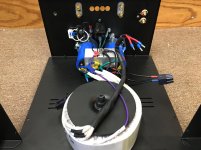 Photo download 5-8-2019 HIFI amp builds 086.jpg981.9 KB · Views: 631
Photo download 5-8-2019 HIFI amp builds 086.jpg981.9 KB · Views: 631 -
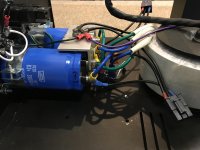 Photo download 5-8-2019 HIFI amp builds 088.jpg884.6 KB · Views: 491
Photo download 5-8-2019 HIFI amp builds 088.jpg884.6 KB · Views: 491 -
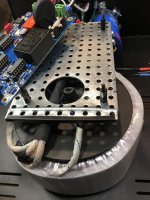 Photo download 5-8-2019 HIFI amp builds 094.jpg618.3 KB · Views: 433
Photo download 5-8-2019 HIFI amp builds 094.jpg618.3 KB · Views: 433 -
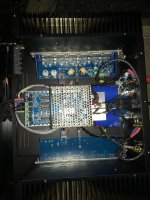 Photo download 5-8-2019 HIFI amp builds 142.jpg580.4 KB · Views: 570
Photo download 5-8-2019 HIFI amp builds 142.jpg580.4 KB · Views: 570 -
 Photo download 5-8-2019 HIFI amp builds 102.jpg1,020 KB · Views: 557
Photo download 5-8-2019 HIFI amp builds 102.jpg1,020 KB · Views: 557 -
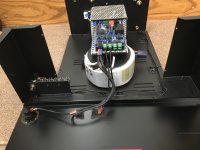 Photo download 5-8-2019 HIFI amp builds 096.jpg947.5 KB · Views: 454
Photo download 5-8-2019 HIFI amp builds 096.jpg947.5 KB · Views: 454 -
 Photo download 5-8-2019 HIFI amp builds 147.jpg715.5 KB · Views: 1,249
Photo download 5-8-2019 HIFI amp builds 147.jpg715.5 KB · Views: 1,249 -
 Photo download 5-8-2019 HIFI amp builds 152.jpg1 MB · Views: 517
Photo download 5-8-2019 HIFI amp builds 152.jpg1 MB · Views: 517 -
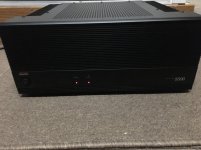 Photo download 5-8-2019 HIFI amp builds 154.jpg978.6 KB · Views: 1,173
Photo download 5-8-2019 HIFI amp builds 154.jpg978.6 KB · Views: 1,173
My new Amp🙂
30 W/4 Ohm, 15 W/8 Ohm
SR 400 V/usec
0 Hz - 8 MHz (can amplify video signal🙂)
Output R: 0.0001 Ohm
400 W full stable power supply +/- 18 V. About 1 Farad inside.
48 BUF634T in each channel (parallel connection).
That's quite an opamp array you have there! Drives down to 2 ohms in bridge mode I suppose from those figures? Audio amp, servo driver and radio transmitter all in one!
This time, here is a Neurochrome Modulus 286 pair installed inside an ancient ADCOM GFA-5300 donor chassis. Included is a simple beer-can power supply, using an Antek AS-3425 transformer with ±33,000µF after the bridge. It has a ground-loop-isolator and a Connexelectronics soft start and associated logic control.
The extraordinary PSSR of the LM3886 composite amp accommodates a very simple power supply, and thus a relatively quick build. It all works a treat, again!
The grounding scheme follows the Hifsonix method.
Instrumentation: Fluke 179 TrueRMS voltmeter, and a Tek TDS1002B 2 ch 60mHz scope.
At a line voltage of 123.0 VAC, and a 440Hz signal, 2 channels driven and loaded, the non-adjusted, raw data for the Modulus-286 was:
8 ohm load: PS = ±35.8 VDC at idle
8 ohm load: PS = ±35.3 VDC at a light load of 2.00 VAC into 8 Ω
8 ohm load: PS = ±33.4 VDC at just under clip, 20.4 VAC into 8 Ω, ( = 52W/Ch )
4 ohm load: PS = ±31.8 VDC at just under clip, 19.3 VAC into 4 Ω, ( = 93W/Ch, )
16 ohm load: PS = ±34.4 VDC at just under clip, 20.5 VAC into 16 Ω, ( = 26W/Ch )
In this application, I was shooting for 65W/Ch into a midbass ScanSpeak 18W8531, which has an impedance saddle of 6.4 ohms from 140 to 300 Hz. The estimated 6Ω power is: (20.4*19.3) / 6 = 66W/Ch = smiles again!
The extraordinary PSSR of the LM3886 composite amp accommodates a very simple power supply, and thus a relatively quick build. It all works a treat, again!
The grounding scheme follows the Hifsonix method.
Instrumentation: Fluke 179 TrueRMS voltmeter, and a Tek TDS1002B 2 ch 60mHz scope.
At a line voltage of 123.0 VAC, and a 440Hz signal, 2 channels driven and loaded, the non-adjusted, raw data for the Modulus-286 was:
8 ohm load: PS = ±35.8 VDC at idle
8 ohm load: PS = ±35.3 VDC at a light load of 2.00 VAC into 8 Ω
8 ohm load: PS = ±33.4 VDC at just under clip, 20.4 VAC into 8 Ω, ( = 52W/Ch )
4 ohm load: PS = ±31.8 VDC at just under clip, 19.3 VAC into 4 Ω, ( = 93W/Ch, )
16 ohm load: PS = ±34.4 VDC at just under clip, 20.5 VAC into 16 Ω, ( = 26W/Ch )
In this application, I was shooting for 65W/Ch into a midbass ScanSpeak 18W8531, which has an impedance saddle of 6.4 ohms from 140 to 300 Hz. The estimated 6Ω power is: (20.4*19.3) / 6 = 66W/Ch = smiles again!
Attachments
-
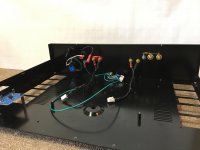 Photo download 5-8-2019 HIFI amp builds 056.jpg721 KB · Views: 403
Photo download 5-8-2019 HIFI amp builds 056.jpg721 KB · Views: 403 -
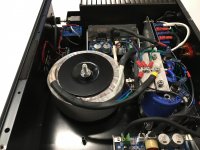 Photo download 5-8-2019 HIFI amp builds 074.jpg844.2 KB · Views: 354
Photo download 5-8-2019 HIFI amp builds 074.jpg844.2 KB · Views: 354 -
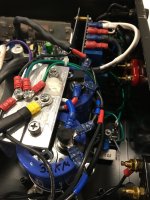 Photo download 5-8-2019 HIFI amp builds 075.jpg558.2 KB · Views: 349
Photo download 5-8-2019 HIFI amp builds 075.jpg558.2 KB · Views: 349 -
 Photo download 5-8-2019 HIFI amp builds 080.jpg831.3 KB · Views: 488
Photo download 5-8-2019 HIFI amp builds 080.jpg831.3 KB · Views: 488 -
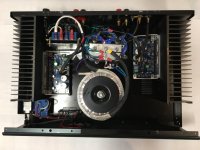 Photo download 5-8-2019 HIFI amp builds 058.jpg859.5 KB · Views: 1,065
Photo download 5-8-2019 HIFI amp builds 058.jpg859.5 KB · Views: 1,065 -
 Photo download 5-8-2019 HIFI amp builds 076.jpg984.5 KB · Views: 317
Photo download 5-8-2019 HIFI amp builds 076.jpg984.5 KB · Views: 317 -
 Photo download 5-8-2019 HIFI amp builds 057.jpg665.4 KB · Views: 1,062
Photo download 5-8-2019 HIFI amp builds 057.jpg665.4 KB · Views: 1,062
Here is a Neurochrome Modulus 686 pair installed inside an ancient ADCOM GFA-5500 donor chassis.
This time, here is a Neurochrome Modulus 286 pair installed inside an ancient ADCOM GFA-5300 donor chassis.
Very nice builds. Thank you for sharing. I love the chassis repurposing. That worked out really well here.
The extraordinary PSSR of the LM3886 composite amp accommodates a very simple power supply, and thus a relatively quick build. It all works a treat, again!
Yep. The error correction employed in the Modulus-series comes with many advantages - including high PSRR.
I'm glad you like the amps.
If anyone here is interested in reading more about the Modulus-286 and Modulus-686 used in these builds, please follow our discussions here:
Neurochrome Modulus-286: 65W (8Ω); 125W (4Ω) @ <-120dB THD Composite Amplifier Module
Modulus-686: 380W (4Ω); 220W (8Ω) Balanced Composite Power Amp with extremely low THD
Tom
Wow! Really impressed with the builds in this thread! This is my poor man's version of the AudioSector chipamp. Still needs to put in place a soft start circuit and perhaps shielding for chip and dc v-wires. Sound is impressive with lots of detail and solid bass.
Attachments
Wow! Really impressed with the builds in this thread! This is my poor man's version of the AudioSector chipamp. Still needs to put in place a soft start circuit and perhaps shielding for chip and dc v-wires. Sound is impressive with lots of detail and solid bass.
Looks good! Seems like a pretty small amount of storage capacitance in the power supply end. You might find that with a bit more in the power supply you get even more/better detail and bass. But if you do that, do make it low ESR if possible.
It already provides more bass and better overall sonics than my quad 303s and Marantz PM94. I am also really surprised with the result as there's only 1500uf per channel. Would using, let's say 60000uf per channel, improve the sonics? (have a m2/f6 power supply board lying around somewhere) 🙂
It already provides more bass and better overall sonics than my quad 303s
I’ve owned at least a dozen 303s. It was a comparo eith my AudioSector that had me giving up on them.
dave
I’ve owned at least a dozen 303s. It was a comparo eith my AudioSector that had me giving up on them.
dave
I still have my 303 from the family hi fi. It's a good backup amp for Quad ESLs, since it won't hurt them and it drives them pretty well. That said, though it's a Peter Walker design, transistor amps have come a long way. Naim stuff from the 80s sounded a lot better to me. Planning to use my 303 case and transformer for a chip amp - sacrilege! 😱
Any more than 1500uF, it wouldn't be a GainClone, just another Chipamp. Check out the original GainCard. 6moons audio reviews: 47 Laboratory Model 4706 GainCard
Member
Joined 2009
Paid Member
Changed from folding to drawing mechanism ... .
Love it!
- Home
- Amplifiers
- Chip Amps
- Chip Amp Photo Gallery
